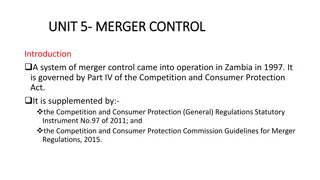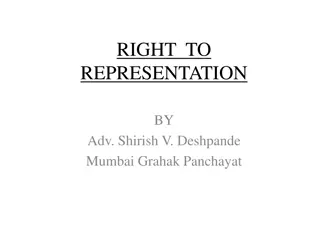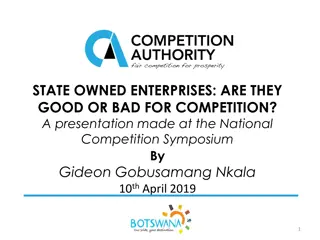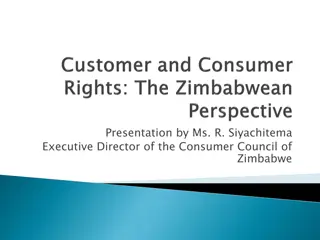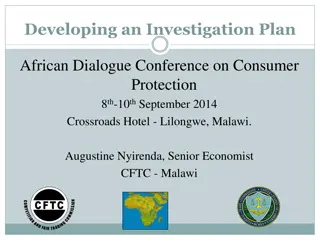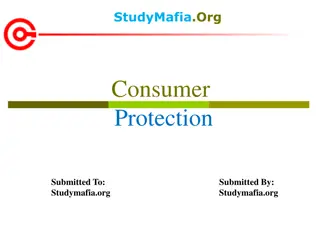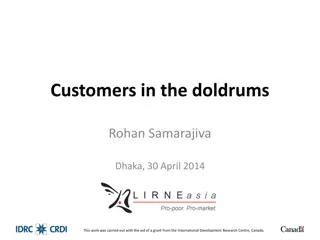Developing an Effective Investigative Plan for Competition and Consumer Protection
Investigative planning is crucial in competition and consumer protection cases to efficiently allocate resources, focus on key issues, and guide investigations. This involves defining the plan, setting objectives, outlining steps for development, and adapting the plan as needed. The process aims to enhance enforcement against anti-competitive practices and mergers while ensuring thorough investigation procedures.
Download Presentation

Please find below an Image/Link to download the presentation.
The content on the website is provided AS IS for your information and personal use only. It may not be sold, licensed, or shared on other websites without obtaining consent from the author.If you encounter any issues during the download, it is possible that the publisher has removed the file from their server.
You are allowed to download the files provided on this website for personal or commercial use, subject to the condition that they are used lawfully. All files are the property of their respective owners.
The content on the website is provided AS IS for your information and personal use only. It may not be sold, licensed, or shared on other websites without obtaining consent from the author.
E N D
Presentation Transcript
Developing Investigative Plan Moses Musantu Competition and Consumer Protection Commission Sixth Annual African Dialogue Conference September, 2014 Competition and Consumer Protection Commission 7/10/2024 1
Presentation Outline Definition of Investigative Plan Objectives of Investigative Planning Steps in development of Investigative Plan Three Primary Areas in IP development Effective investigative tools Investigative Plan as tool for Evaluation Example: Fertiliser Case Investigative Plan Conclusion Competition and Consumer Protection Commission 7/10/2024 2
Definition of Investigative Plan Investigative Plan (IP) refers to a plan developed by an Investigator or investigation team setting out the investigative and administrative tasks relevant to proving the alleged contravention of the Competition Law. The IP is a living document that should be revised throughout the life of the investigation. An IP sets priorities for the investigation and focusses the investigation on particular theories of harm. The IP serves to guide the investigation and its structure will be based on the specific issues of each investigation (depending on whether it s a merger or RBP case). IP detail investigative actions and milestones, and may incorporate dates, budgets and staff availability. Competition and Consumer Protection Commission 7/10/2024 3
Objectives of Investigative Planning The objectives of establishing the IP are to assign scarce agency resources to enhance anti- competitive trade practices and mergers enforcement and foster the success of an investigation `Vital to ascertain whether the complaint is frivolous or vexatious at Preliminary Stage before embarking on a full fledged investigation (Section 56 of the Competition and Consumer Protection Act # 24 of 2010) Competition and Consumer Protection Commission 7/10/2024 4
Steps in development of IP There is no single model for IP. It is a continuous process driven by the course of the investigation and should serve as a guide for the investigation. Accordingly, IPs should be revised and adjusted to reflect the developments and the understanding of the case. The IP should show what is to be done, how and when it will be done and who will do each task. The development of IP should be preceded by brainstorming by the Investigation Team Competition and Consumer Protection Commission 7/10/2024 5
Steps in development of IP Cont Brainstorming sessions should be based on critical issues which include but not limited to: all possible theories of harm, identification of possible sources of information to evaluate the theories, consideration of the required time to complete goals, consideration of resources needed and development of a written plan. Competition and Consumer Protection Commission 7/10/2024 6
Three Primary Areas in IP Development Theories-developing and tracking various theories of harm IP should include the main issues to be investigated by identifying the working theory of harm for the and any unresolved questions critical to the investigation The investigation team may also consider identifying possible remedies to be sought Evidence-identifying sources of evidence and pertinent facts to help evaluate the investigative theories Focus on how to develop the information necessary test the theories and to evaluate the significance of possible effects. The evidence portion of the IP should identify the types of information needed to resolve the key questions, the likely sources of information and the method to gather the needed information. 1. investigation 2. to Competition and Consumer Protection Commission 7/10/2024 7
Three Primary Areas in IP Cont: Tasks-specifying administrative tasks and scrutiny of available time assignments, including careful IP should include an overall timing plan for the completion of the investigation The agenda should incorporate important upcoming dates The most important administrative aspect to include in the IP is a schedule of tasks, or agenda for the investigation. The agenda should help to identify specific tasks, assign responsibilities and set deadlines. Such tasks include the evidence gathering methods mentioned above and other more administrative items. Competition and Consumer Protection Commission 7/10/2024 8
Effective Investigative tools Effective investigative tools for evidence gathering to be included in the IP include: Dawn raids (unannounced search) Telephone and physical interviews Research findings Responses from third parties and industry experts Note in a cartel investigation, dawnraids can minimise the opportunity for document destruction and concealment and can avoid deliberate or inadvertent failure to produce documents following Commission s requests. Competition and Consumer Protection Commission 7/10/2024 9
Investigative Plan as tool for Evaluation The IP is used to track overall progress and inform all members of the investigation team The Commission hold formal internal meetings periodically to update Departmental members, Director and Executive Director on the progress of the investigation The meetings act as an M & E tool to track progress and provide opportunities to discuss the theories underlying the investigation Remember an IP is a living product to be revised throughout the investigation Competition and Consumer Protection Commission 7/10/2024 10
Example: Fertiliser Case IP CCPC on 4th September, 2012 received a complaint about cartelistic behaviour by two firms contracted to supply Fertiliser under Government sponsored FISP Programme It was alleged that the two firms were involved in market allocation and price fixing Necessary authorisation and brainstorming meetings were done Necessary theories of harm, evidence and tasks were identified and outlined in the IP Competition and Consumer Protection Commission 7/10/2024 11
Example: Fertiliser Case IP cont. As earlier stated, the IP is a living document and the Fertiliser case IP was being revised during the course of the Investigation. The major changes that occurred from the point of receiving the complaint to closure of investigation included: Date of dawnraid Conducting of a surveillance on the two enterprises Identification of extra offices to search for information Non involvement of the National Procurement Authority Involvement of the Anti Corruption Body during the planning and execution of the Dawnraid Competition and Consumer Protection Commission 7/10/2024 12
Conclusion A key premise of the IP is that from the outset, the theory of possible harm should be well defined. As the investigation proceeds, however, it is critical to adapt and update the plan, for instance, by noting accomplished tasks, making certain theories as irrelevant, or highlighting new working theories and unresolved questions. Remember, Investigative planning is a fluid, continuous process driven by the course of the investigation. At its best, the investigation plan serves as a guide for the investigation, not a burden. Competition and Consumer Protection Commission 7/10/2024 13
THE END May God Bless You All Competition and Consumer Protection Commission 7/10/2024 14





